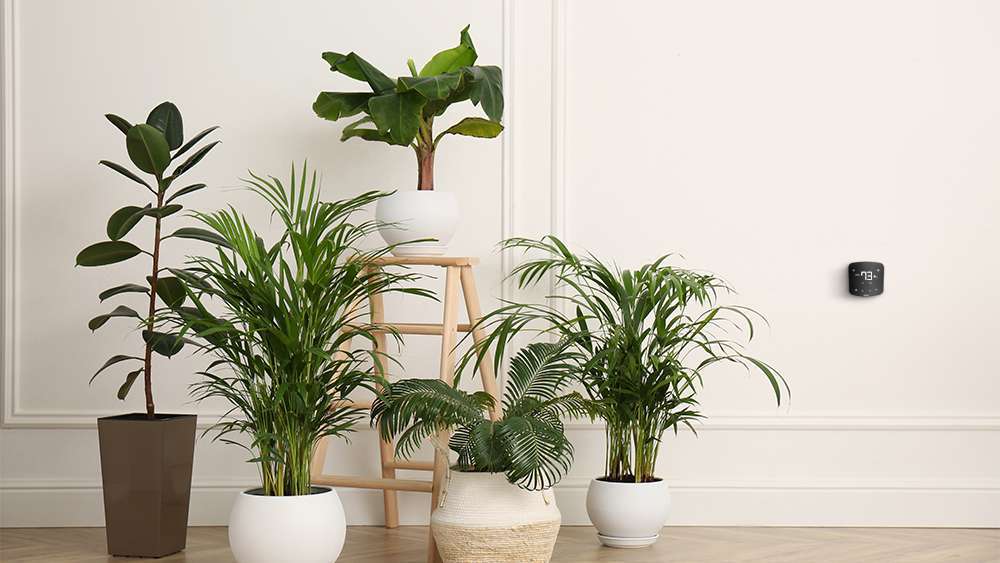
Key Takeaways
- Houseplants reduce stress, boost mood, and help purify indoor air.
- NASA’s Clean Air Study shows that specific plants can filter air pollutants, but a large number is required to see noticeable effects.
- Some effective air-purifying plants are English Ivy, Bamboo Palm, and Parlor Palm.
Worried about indoor air quality as pollution and CO2 levels rise? Indoor air purifying plants are a pretty cool solution that not only remove toxins but also add a spark to your room’s ambiance!
It’s no secret that plants keep the air fresh and clean. However, some house plants have additional air-purifying benefits making them a popular addition to home and office designs. While aiding your home’s HVAC system, plants help boost your mood and productivity. Besides they also aid in reducing stress!
But is it proven if plants actually purify the air? Which air-purifying plants are the best? How many air-purifying indoor plants would be enough to keep your air clean?
Do Plants Purify Air?
Air-purifying indoor plants have been all the rage ever since a 1989 NASA study championed the air-purifying benefits of houseplants. The study revealed that plants have the ability to reduce indoor air pollutants.
There is no doubt that plants can remove volatile chemical toxins from the air. Still, some critics claim that houseplants make a negligible difference in improving the cleanliness levels of indoor air. The reason is that even though plants are continuously cleaning the air, the process is too slow in reality to make any significant difference.
Therefore, you need a high concentration of house plants to purify the air inside your house. Just a handful won’t cut it. Some researchers claim that it would take 93 plants per square foot to compete with a building’s ventilation system!
So does that mean you shouldn’t bother with air-purifying houseplants at all? Not quite.
Another study conducted a practical experiment in offices shows that potted plants provide an efficient, automated system for indoor air pollution. This compliments other engineering measures to help reduce the intensity. Further studies also back up Nasa’s original findings claiming that certain plants certainly can at least complement ventilation systems. Hence, decreasing the level of air pollution.
While keeping a few houseplants alone won’t purify the air significantly, they still have a host of other benefits, making them worthwhile.
Benefits of Air Purifying Indoor Plants
Indoor plants have been found to significantly reduce stress levels. Moreover, they are therapeutic for people with depression and anxiety. Medical Clinics in Manchester, England, have taken the initiative to prescribe plants to patients with depression or anxiety.
In addition, CEOs and managers might be pleased to hear that employees who work around natural elements such as indoor plants are significantly more satisfied and committed to their organization. Some of them are also used as humidity absorbing plants hence decreasing the chances of mold production.
Your best choice to make any mini-split, window,
or portable AC smart. Enhance your comfort and savings.

Here is a summary of the indoor air purifying benefits of plants, making the decision to include them in your home a no-brainer!
- Maintain home humidity levels
- Maintain home temperature
- Reduce carbon dioxide
- Remove certain pollutants from the air
- Reduce dust from the air
How Do Plants Purify Air?
The ability of plants to detoxify the air is extraordinary. While leaves absorb carbon dioxide and light, converting them into energy through photosynthesis, they also absorb volatile organic compounds (VOCs) from the air. Thus, the leafier the plant, the more toxins it will be able to absorb.
Oxygen is a valuable byproduct of this process. Plants remove harmful pollutants increasing oxygen content, something no commercial air purifier can do.
Common Indoor Pollutants
While your home is your safe haven, your indoor air can be more toxic than outdoor air.
Unknowingly we bring in various contaminants making indoor air pollution a legitimate health and environmental concern. Not all are very harmful, but high concentrations can cause dizziness or allergies.
VOCs such as formaldehyde in beauty products or toluene in paints are some common indoor air pollutants. Here are some more that you can diminish with the help of air purifying house plants and air purifiers:
- Formaldehyde: Commonly used in building materials, high levels of formaldehyde are associated with an increased risk of certain rare cancers. The general public is exposed to formaldehyde by absorbing liquids containing formaldehyde (cleaning products, etc.) through the skin or by inhaling formaldehyde present in the air due to tobacco smoke, automobile tailpipe emissions, etc.
- Benzene: A widely used industrial chemical, benzene is found in crude oil and is used to make plastics, resins, synthetic fibers, glues, adhesives, cleaning products, and detergents, etc. Long-term benzene exposure is linked to an increased risk of leukemia and anemia.
- Toluene: Found naturally in crude oil, toluene is present in paints, lacquers, glues, and nail polishes. Though exposure to moderate levels of toluene is harmless, high levels of toluene can cause dizziness, loss of coordination, insomnia, etc.
- Xylene: Widely used in the petroleum and wood processing industries, exposure to xylene can cause eyes, nose, and throat irritation, headaches, dizziness, and loss of muscle coordination.
- Trichloroethylene: Found in consumer products such as paint removers, adhesives, spot removers, and rug cleaning fluids, trichloroethylene is associated with central nervous system problems such as blurred vision, facial numbness, and confusion. There is also increasing evidence that trichloroethylene is human carcinogenic.
21 Best Air Purifying Plants
While air purifying plants cannot instantly filter your home atmosphere like a mechanical ventilation system or an air purifier, they certainly can aid the process with their marvelous air cleaning abilities.
Not all plants are the same; here is a roundup of some of the best air purifying house plants that you can utilize for a toxin-free indoor environment:
1. English Ivy (Hedera Helix)
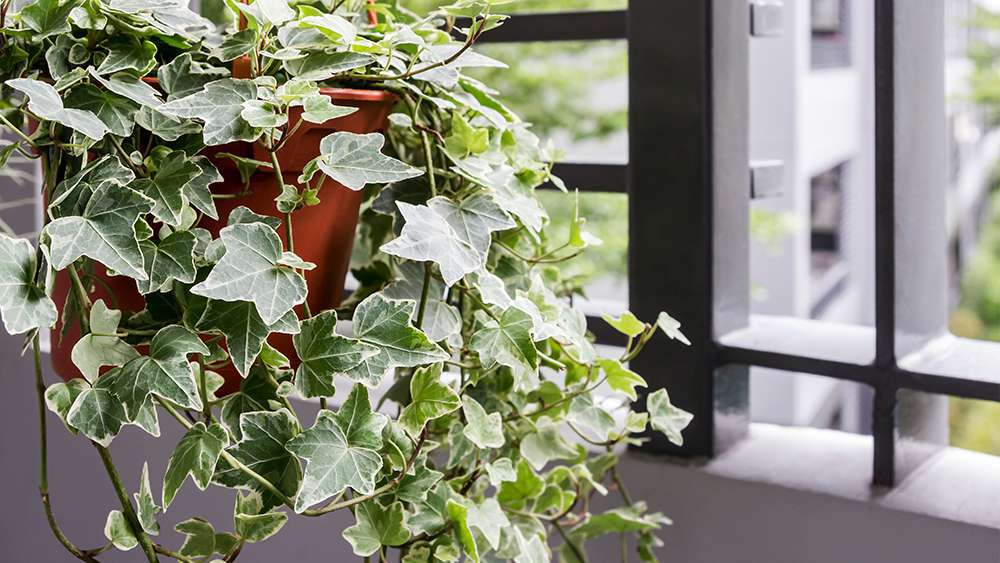
English ivies are one of the best air-purifying plants, according to a NASA study. They can remove toxins like formaldehyde, benzene, xylene, and toluene. Some studies also claim they can reduce mold and fecal matter in the air. Hedera helix also absorbs humidity and can be helpful in maintaining your ideal summer humidity levels.
Maintenance Tips: English ivies do need a lot of bright but indirect sunlight. They love humidity and cooler temperatures in the 60s range. Let the top of the soil dry to the touch before watering them again. Keep in mind that English ivies are considered an invasive species in many parts of the world as they are very fast growing. Trim them regularly so they don’t take over your walls.
Toxicity: Unfortunately, this amazing plant is not pet safe. A toxin found in the leaves and berries can be hazardous to both children and animals if eaten.
2. Bamboo Palm (Chamaedorea Seifrizii)

Belonging to the Chamaedorea genus with over 100 species to choose from, the bamboo palm is another popular air-purifying houseplant. The most popular species considered to be the bamboo palm is the chamaedorea seifrizii.
Maintenance Tips: Bamboo palms are low-maintenance plants, thus perfect for beginners. They dislike direct sunlight and overwatering. 1-3 waterings a week are more than enough.
Toxicity: These fantastic plants are pet-friendly, so you don’t have to worry about their placement.
3. Parlor Palm (Chamaedorea Elegans)

The beautiful parlor palm, also known as Bella palm or tabletop palm, has long, shiny green leaves. Parlor palms are known to remove harmful chemicals such as benzene and trichloroethylene from the air.
Maintenance Tips: You will be pleased to learn that it is a low-maintenance plant that can adapt to various lighting conditions. It does best in bright, filtered light with little watering. It is better to underwater your parlor palm than to overwater it. Expect to water them every 1-2 weeks.
Toxicity: Parlor palms are also pet safe, so you can keep them without worrying about your pet’s health.
4. Areca Palm (Dypsis lutescens)
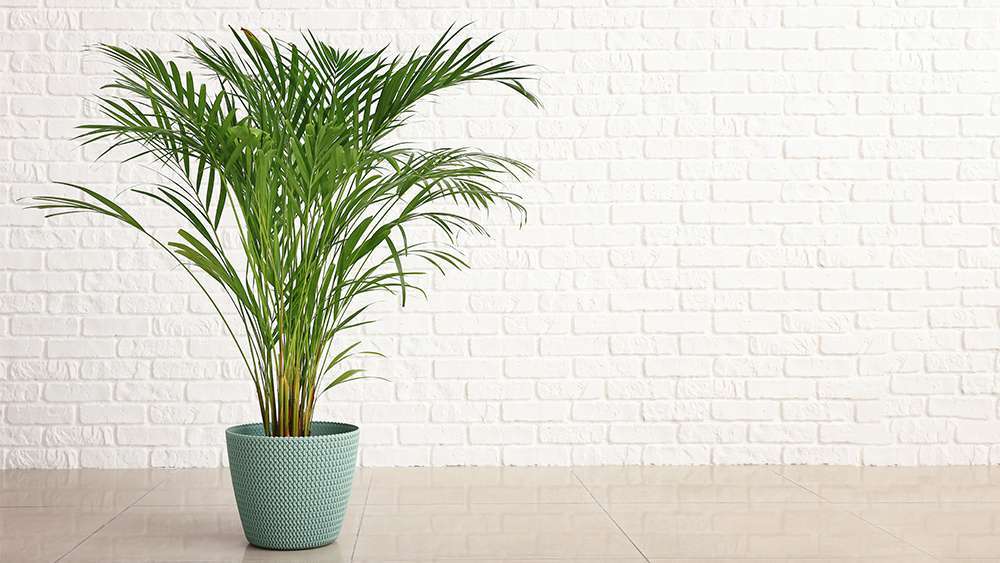
The areca palm is a popular air-purifying houseplant capable of removing formaldehyde, xylene, benzene, trichloroethylene, and carbon monoxide from the air. Its slender, arching fronds make it a beautiful addition to any room.
Maintenance Tips: Areca palms prefer bright, filtered sunlight. Harsh direct sunlight can scorch the foliage. They prefer moist soil; however, make sure you let the soil dry slightly between waterings as they dislike waterlogged soil. They do best in temperatures between 65 to 75 degrees.
Toxicity: Apart from being a stunning design addition, the areca palm is also pet safe, so you can rest easy knowing your pet is in no danger.
5. Gerbera Daisy (Gerbera Jamesonii)
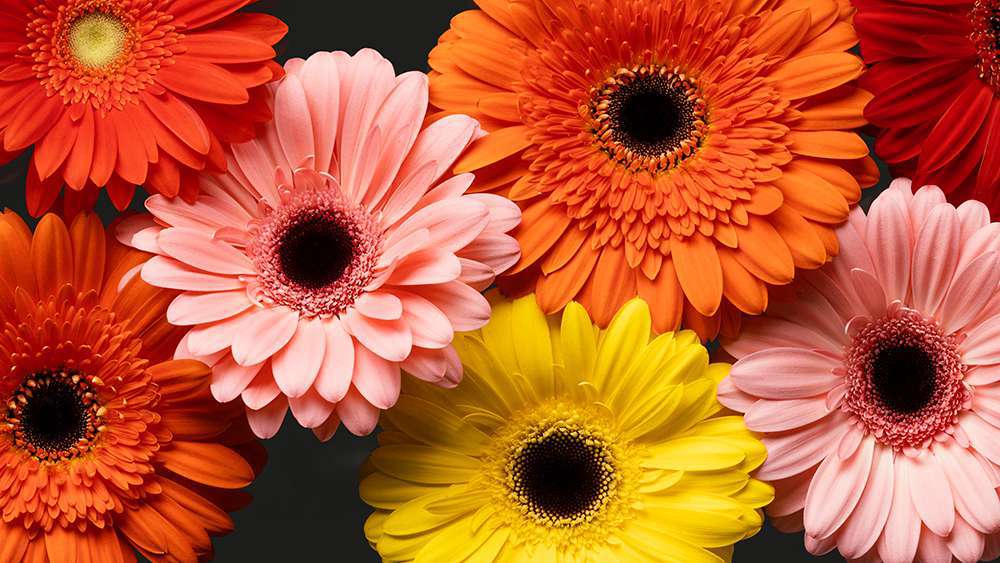
Another plant that was highly rated in NASA’s 1989 Clean Air Study is the Gerbera Daisy. In 24 hours, this fantastic air-purifying plant cleaned the air dramatically. It removed half of the airborne formaldehyde, 67% benzene, and 35% trichloroethylene.
Maintenance Tips: Gerbera daisies do best in a place with moderate sunlight. Although they prefer bright sunlight, placing them in direct sunlight can end up scorching the leaves. Gerbera daisies do need to be watered regularly. Just water them when the soil has dried an inch or two below the surface.
Toxicity: Gerbera Daisies are also pet safe, so you can add these bright flowers to your home without worrying about your pet’s health.
6. Dragon Tree (Dracaena Dorado)

Plants belonging to the Dracaena family are also among the best air-purifying plants in general. The dragon tree is no exception. It excels at removing benzene, xylene, trichloroethylene, formaldehyde, and carbon dioxide from the air.
Maintenance Tips: The dragon tree is an excellent indoor plant due to its hardy nature. Dragon trees prefer indirect, bright sunlight, and generally, they do best if they receive around 10 hours of it. Dragon trees are susceptible to root rot if left in standing water. Allow the soil to partially dry before watering them again.
Toxicity: The dragon tree is toxic to pets and should be avoided by pet owners.
7. Mother-in-Law’s Tongue (Dracaena trifasciata)
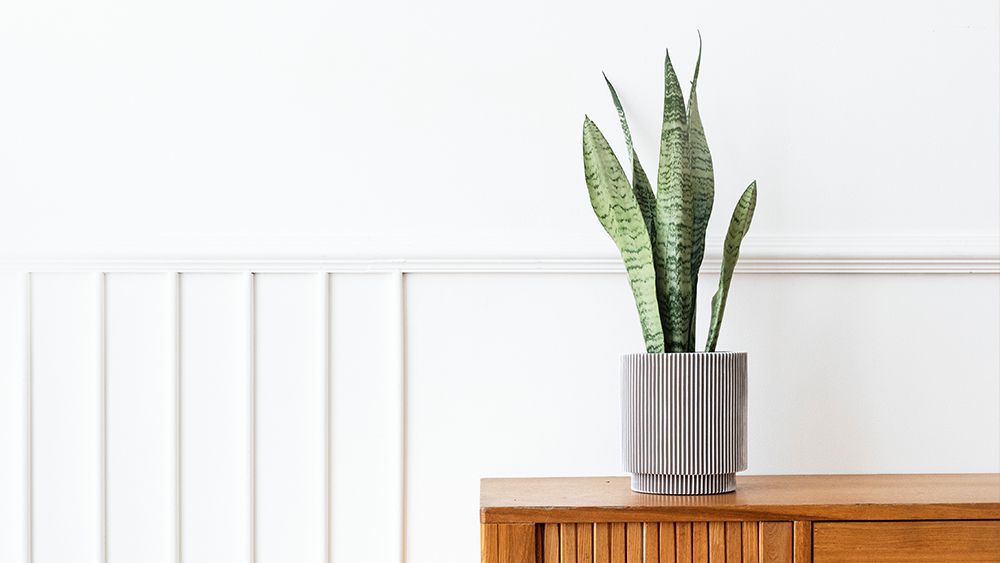
Mother-in-law’s tongue, also known as snake plant or St. George’s sword, is another brilliant air-purifying plant from the Dracaena family. It can remove a substantial amount of formaldehyde and benzene.
Maintenance Tips: A hardy plant, mother-in-law’s tongue can survive in a variety of lighting conditions. It is also drought-resistant and does not react kindly to overwatering. Water only when the soil feels dry. In warmer months, it only needs to be watered every 3-4 weeks.
Toxicity: Mother-in-law’s tongue contains saponins, a toxic substance for cats and dogs, so households with pets should look for another houseplant.
8. Pot Mum (Chrysanthemum Morifolium)

The pot mum, also known as the florist’s mum, isn’t considered one of the best air-purifying indoor plants for nothing. According to NASA’s Clean Air Study, the small yet mighty chrysanthemum can remove 61% formaldehyde, 53% benzene, and 41.2% trichloroethylene.
Maintenance Tips: This colorful houseplant is widely available and only needs a bit of tender loving care to thrive. Pot mums love sunlight and need at least 4 hours of direct sunlight a day. They are also thirsty plants and need to be watered regularly. Check the top 1 inch of the soil; they need to be watered if it feels dry. Water them until it starts to drain from the bottom of the pot.
Toxicity: It’s important to keep in mind that pot mums are not animal friendly. As such, they should only be considered by households with no pets.
9. Peace Lily (Spathiphyllum)
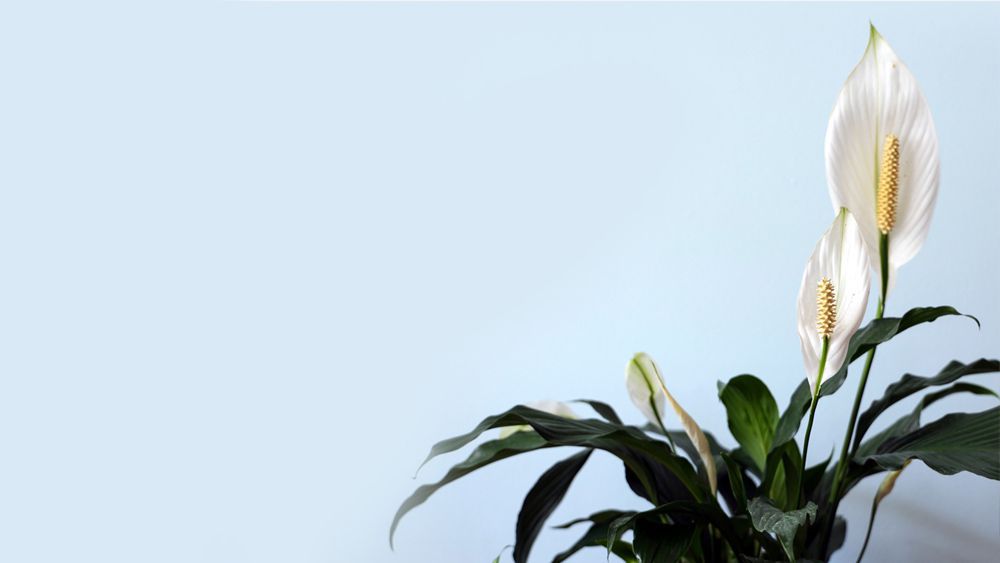
The peace lily is known for being a superstar when it comes to removing benzene from the air. In addition, its beautiful white flowers and light scent make this powerful air-purifying plant an attractive option for homeowners.
Maintenance Tips: Peace lilies need bright, filtered light and prefer warmer humid climates. Therefore, they need to be watered and misted frequently in the summers. You can get away with less watering in the winters but be careful not to let the soil dry out.
Toxicity: Unfortunately, peace lilies are not pet safe. If you are eager to plant peace lilies, make sure they are in an area where your pets cannot reach them.
10. Flamingo Lily (Anthurium Andraeanum)

The flamingo lily is a colorful air-purifying houseplant that is a feast for the eyes. Apart from being beautiful to look at, it can remove airborne formaldehyde, ammonia, toluene, and xylene.
Maintenance Tips: Unfortunately, the flamingo lily is not the lowest maintenance plant there is. You need a bit of a green thumb to grow this temperamental plant. Native to Central and South America, the flamingo lily favors high humidity and temperatures. Direct sunlight burns their leaves, so place them in bright, indirect light. Let the soil dry slightly between waterings.
Toxicity: The flamingo lily is toxic to humans and pets, hence it should be avoided in the household with pets and children.
11. Spider Plant (Chlorophytum Comosum)
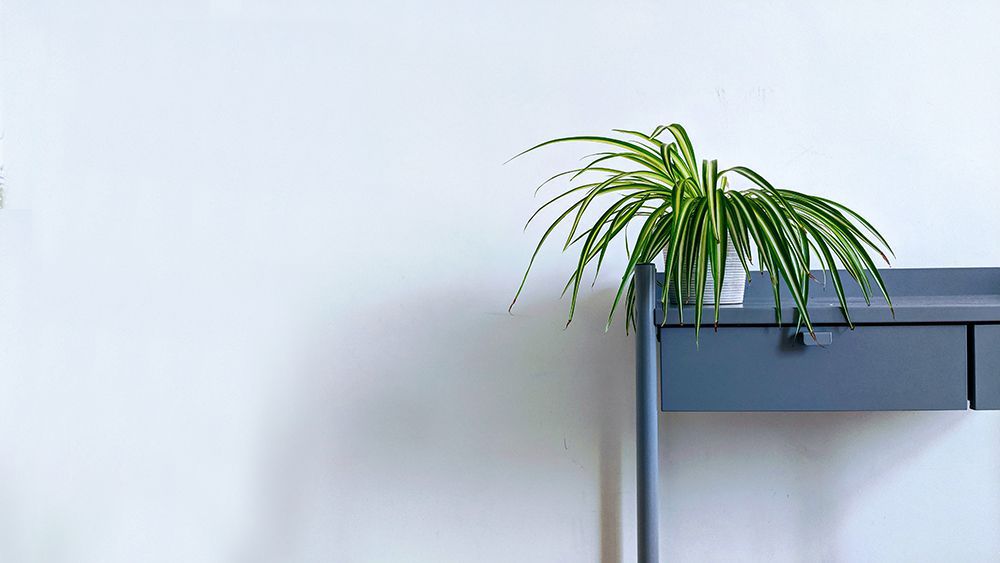
The spider plant, also known as ribbon plant or spider ivy, has slender, arching lime-green leaves and can remove harmful pollutants like carbon monoxide, formaldehyde, xylene, and benzene from the air. It’s a popular air-purifying indoor plant, thanks to its gorgeous leaves and air filtering capabilities.
Maintenance Tips: The spider plant is also one of the lowest maintenance houseplants. They prefer indirect light and can even thrive in low light conditions. However, make sure you keep them out of direct sunlight as it can scorch their leaves. In addition, they dislike soggy soil and only need a light spritzing occasionally.
Toxicity: The spider plant is also one of the few houseplants that are nontoxic to animals.
12. Mass Cane (Dracaena Massangeana)

Another air-purifying powerhouse, the mass cane, can remove up to 70% of airborne formaldehyde. These low-maintenance plants resemble palm trees a lot, which is why they are sometimes called “false palms.”
Maintenance Tips: They grow best near windows with filtered sunlight. Direct sunlight can cause their leaves to burn and wilt. They need a moderate amount of water and require humidity levels between 40-50%. Soil that is too wet or dry causes health issues in the plant.
Toxicity: Keep in mind; the Dracaena Massangeana is not a pet-friendly plant. It is toxic to both cats and dogs.
13. Rubber Tree (Ficus Elastica)

Used for making rubber before synthetics were invented, the rubber plant is an air-purifying wonder. It excels at removing formaldehyde from the air. Apart from that, it produces tons of oxygen and eliminates bacteria and mold spores from the air. These features make it a worthy addition to your collection of air-purifying plants.
Maintenance Tips: Though it is generally an easy-to-care plant, there are some maintenance tips you need to know. The rubber tree thrives in medium to bright indirect light. Water every 1-2 weeks and allow the soil to dry out between waterings. The rubber plant also dislikes very cold temperatures, so don’t let temperatures drop below 60 degrees.
Toxicity: The rubber tree is mildly toxic to both humans and pets. If you decide to grow one, make sure it is out of reach of animals and children.
14. Heart Leaf Philodendron (Philodendron Oxycardium)
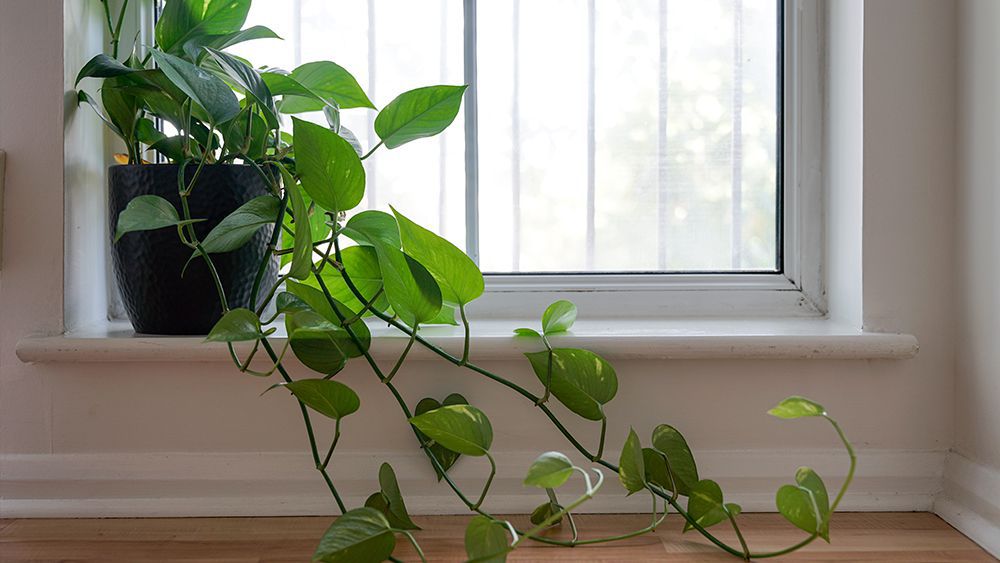
With glossy, heart-shaped leaves, the heartleaf philodendron will be a worthy addition to your air-purifying indoor plant collection. These trailing plants can be planted in hanging baskets or trained to climb up a trellis or a pole.
Maintenance Tips: The heartleaf philodendron only needs medium, indirect light and should be watered every 1-2 weeks. Allow the soil to dry out between waterings and increase the frequency of watering as light increases.
Toxicity: It is toxic to humans and pets, so households with pets or children should avoid keeping one.
15. Aloe Vera

Aloe vera is well known for its skin-soothing properties. However, you may be surprised to find out that it is just as good for the air as it is for your skin. This air-purifying plant removes benzene, formaldehyde, and carbon monoxide from the air.
Maintenance Tips: Place aloe vera in a spot with bright, indirect sunlight as direct sunlight can burn its leaves. Allow the soil to dry out completely between waterings. Most aloes do not need any water in the winter, so just moisten their soil a little bit.
Toxicity: Unfortunately, aloe vera is toxic to cats and dogs, and its thorny leaves can be dangerous.
16. Fittonia (Fittonia Argyroneura)

Otherwise known as the nerve plant or mosaic plant, Fittonia is a popular air-purifying houseplant due to its lush, patterned leaves. Not only is it a beautiful plant, but it also has some amazing air-purifying benefits. It is effective at removing benzene, toluene, and trichloroethylene from the air.
Maintenance Tips: Unlike the other plants on this list, fittonia is somewhat temperamental and needs a lot of attention. They require high humidity and, as such, do well in bathrooms or terrariums. They prefer bright, indirect sunlight and lots of water. However, make sure the pot has appropriate drainage since standing water can cause yellowed, limp leaves.
Toxicity: Good news for pet owners, fittonia is one of the few air-purifying plants that is completely pet safe.
17. Chinese Evergreen (Aglaonema Modestum)

Famous for being near indestructible, the Chinese evergreen is the best air-purifying plant for beginners. They come in a wide variety of colors and filter toxins such as benzene, formaldehyde, trichloroethylene.
Maintenance Tips: Chinese evergreens prefer low light conditions though they can also thrive in bright, indirect light. These plants also do better in warmer, humid conditions. The soil should be moist but wait for the top two inches to dry out before watering again.
Toxicity: Unfortunately, this hardy plant is not pet safe and should be avoided by pet owners.
18. Weeping Fig (Ficus Benjamina)

Also known as the ficus tree or Benjamin fig, this common houseplant is a potent air purifier. With its slender, arching branches, it is a popular aesthetic choice for home decor.
Maintenance Tips: Indoors, the weeping fig prefers plenty of indirect sunlight with the occasional dose of direct sunlight. The weeping fig loves moisture and you should water them regularly. However, do not let it sit in water as it may develop root rot. Since it is a tropical plant, it prefers warmer temperatures and higher humidity. You can use a humidifier to increase humidity or mist the leaves regularly.
Toxicity: The weeping fig is toxic to cats and dogs and should be avoided by pet owners.
19. Poinsettia (Euphorbia Pulcherrima)

A popular plant during the holiday season, poinsettias are a good option all year round too. The beautiful bright pink blooms are a sight for sore eyes, and their ability to remove trace formaldehyde from the air makes them a health-conscious choice too.
Maintenance Tips: Poinsettias love the sun, giving them 6-8 hours of bright, indirect sunlight is essential. Direct sunlight can burn their leaves. Water them whenever the surface feels dry to the touch; however, don’t let the roots sit in water. Poinsettias are very sensitive to the cold and prefer temperatures between 65 to 75 degrees.
Toxicity: Though poinsettia is mildly toxic to pets, the side effects are not usually severe. According to the ASPCA, its toxicity is overrated. However, you may still want to pick another air-purifying indoor plant to be on the safe side. If you do decide to keep one, place it where your pet cannot reach it.
20. Boston Fern (Nephrolepis Exaltata)
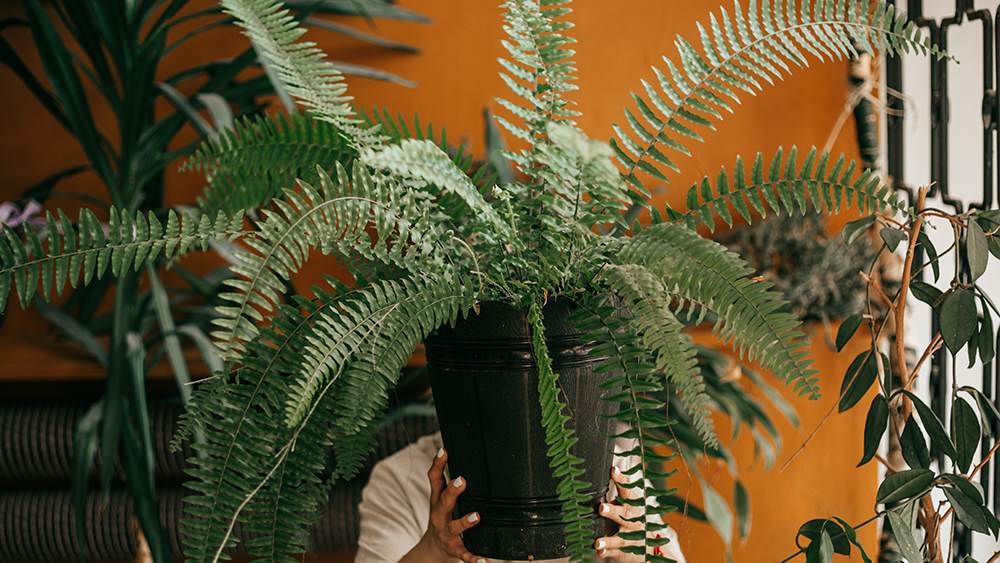
The Boston fern, also known as the sword fern, is a popular houseplant choice due to its lush green arching fronds and air purifying abilities. It removes xylene, toluene, benzene, and formaldehyde from the air.
Maintenance Tips: Boston ferns prefer bright, indirect light as direct sunlight can burn their fronds. The soil always needs to be lightly moist, not soggy. They need humidity levels above 80% and dislike extreme temperatures.
Toxicity: The good news for pet owners is that the Boston fern is non-toxic for pets. So you can let your inner gardener free without worrying about your pet’s health.
21. Golden Pothos (Epipremnum Aureum)

This leafy vine looks beautiful hung midair or placed on a shelf. Also known as satin or silk pothos, it is one of the lowest maintenance air-purifying plants. It filters a variety of toxins, including toluene, formaldehyde, xylene, trichloroethylene, and benzene.
Maintenance Tips: The golden pothos thrives in bright, indirect light but can also adapt to low light conditions. Water your pothos every 1-2 weeks and allow the soil to dry out between waterings.
Toxicity: The golden pothos is toxic to cats and dogs, so pet owners should consider other pet-safe houseplants.
Coupling Air Purifying Plants With an Air Purifier
If you decide to get an air-purifying indoor plant, keep in mind that one plant alone can’t significantly improve indoor air quality. However, it can aid and help. To purify the air inside your house to a great extent, you may have to look at other measures to improve indoor air quality.
A great way to purify the air in your home is to complement air purifying plants with a high-quality air purifier. While air-purifying plants can remove harmful gases, they cannot remove pollen and bacteria. Combining air purifying plants with an air purifier can increase oxygen content while removing harmful pollutants, pollen, and pet dander.
Pro Tip: You need to keep a good eye on humidity levels when taking care of air-purifying house plants. While it can get tiring, we have a smart solution for you. Use smart AC controllers or smart thermostats to control humidity indoors. Features such as Comfy Mode allow you to set humidity ranges, and your air conditioning will turn on/off automatically as required.
Houseplants are a fantastic way to bring some nature into your busy lives. Caring for plants is therapeutic and fosters a new appreciation for all things green. Bringing any one of these plants into your life will be a decision you will never regret. Happy gardening!









1 Comment. Leave new
Thanks for the useful information! I wanted to add more of these types of plants but didn’t know where to start. Now I have some ideas.